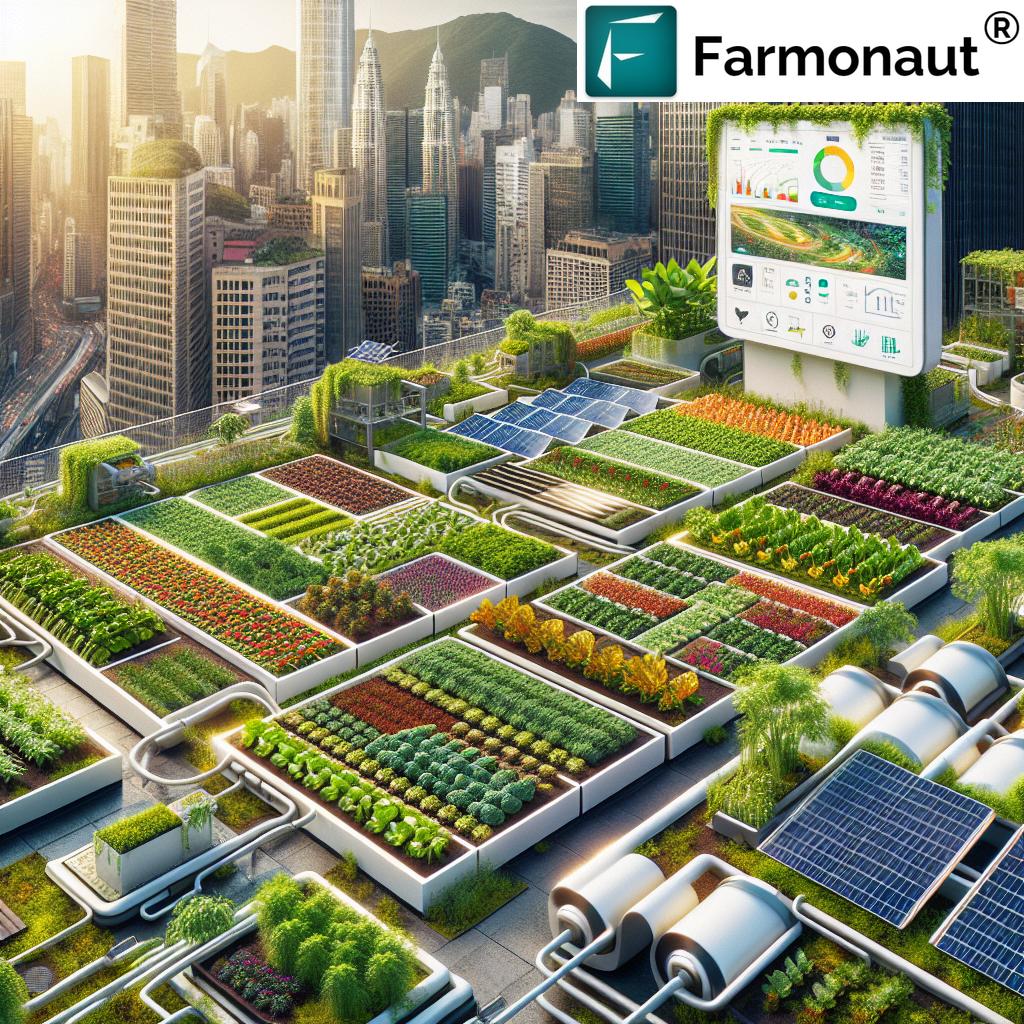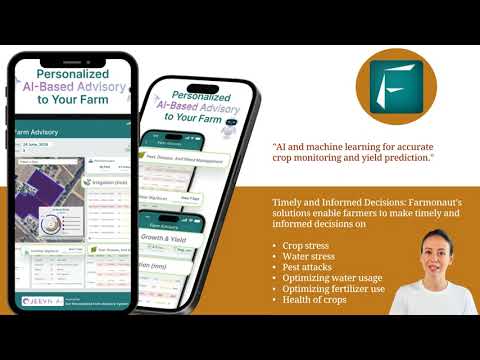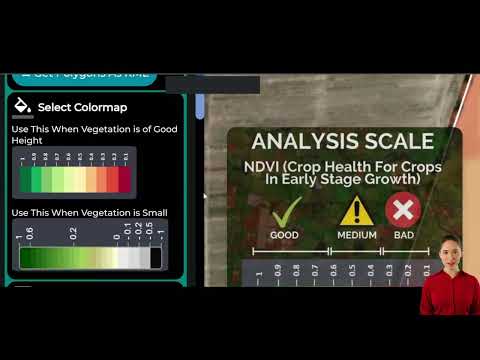Revolutionizing Urban Agriculture: How Farmonaut’s Innovative Technology Supports USDA’s $43.1 Million Initiative
“The USDA’s $43.1 million initiative supports urban agriculture projects, including composting and food waste reduction efforts.”
In an era where urban spaces are evolving to meet the growing demand for sustainable living, we’re witnessing a remarkable transformation in the landscape of urban agriculture. The United States Department of Agriculture (USDA) has taken a monumental step forward with its groundbreaking $43.1 million funding initiative aimed at revolutionizing urban and suburban food systems. This visionary investment is set to reshape the way we think about food production in our cities, promoting innovative farming practices and enhancing food security for millions of Americans.
As we delve into the intricacies of this transformative initiative, we’ll explore how cutting-edge technologies, like those offered by Farmonaut, are playing a pivotal role in supporting and amplifying the impact of these urban agriculture grants. From satellite-based crop monitoring to AI-driven advisory systems, we’ll uncover how these innovations are helping to create more resilient, efficient, and sustainable urban food production systems.
Understanding the USDA’s $43.1 Million Urban Agriculture Initiative
The USDA’s ambitious initiative is a testament to the growing recognition of urban agriculture’s potential to address food security, sustainability, and economic development in cities across the United States. This comprehensive program encompasses a wide range of projects and priorities, all aimed at fostering a more robust and equitable urban food system. Let’s break down the key components of this transformative investment:
- Composting and Food Waste Reduction: A significant portion of the funding is allocated to projects that focus on composting and reducing food waste in urban areas. These initiatives not only help to minimize environmental impact but also create valuable resources for urban farms and gardens.
- Community-Supported Agriculture (CSA) Programs: The USDA is investing in CSA programs that connect urban consumers directly with local farmers, fostering stronger community ties and ensuring fresher, more affordable produce for city dwellers.
- Urban County Agricultural Committees: Recognizing the unique challenges faced by urban farmers, the initiative includes the establishment of specialized committees to address city-specific agricultural issues and develop tailored solutions.
- Innovative Food Production Technologies: A portion of the funding is dedicated to supporting the implementation of cutting-edge agricultural technologies in urban settings, including vertical farming, hydroponics, and smart irrigation systems.
- Equity-Focused Initiatives: The USDA is placing a strong emphasis on projects that prioritize underserved communities, aiming to improve access to nutritious, affordable food in areas that have historically faced food insecurity.
This multi-faceted approach demonstrates the USDA’s commitment to not only increasing food production in urban areas but also to building a more resilient and equitable food system that benefits all members of urban communities.
The Role of Technology in Urban Agriculture
As we explore the potential of urban agriculture, it’s crucial to understand the pivotal role that technology plays in making these initiatives successful and sustainable. Innovative companies like Farmonaut are at the forefront of this technological revolution, offering solutions that address the unique challenges of urban farming.
Farmonaut’s satellite-based farm management solutions are particularly well-suited to support the USDA’s urban agriculture initiatives. By leveraging advanced satellite imagery and artificial intelligence, Farmonaut provides urban farmers with real-time insights into crop health, soil conditions, and resource management. This technology is invaluable for maximizing productivity in limited urban spaces and ensuring the efficient use of resources.
Key technological advancements supporting urban agriculture:
- Satellite-Based Crop Monitoring: Farmonaut’s technology allows urban farmers to track crop health and growth patterns without the need for extensive on-site equipment.
- AI-Powered Advisory Systems: The Jeevn AI system provides personalized recommendations for crop management, helping urban farmers make informed decisions about irrigation, fertilization, and pest control.
- Blockchain-Based Traceability: This technology ensures transparency in the urban food supply chain, building trust between producers and consumers.
- Resource Management Tools: Farmonaut’s platform helps urban farmers optimize their use of water, fertilizers, and other inputs, promoting sustainability and cost-efficiency.
These technological solutions align perfectly with the USDA’s goals of promoting sustainable farming practices and enhancing food security in urban areas. By incorporating these innovations, urban agriculture projects can achieve higher yields, reduce waste, and create more resilient local food systems.

Composting and Food Waste Reduction: A Key Focus
One of the most significant aspects of the USDA’s urban agriculture initiative is its emphasis on composting and food waste reduction. These efforts are crucial for creating a circular economy within urban food systems and reducing the environmental impact of cities. Let’s explore how this focus area is being addressed and supported by innovative technologies:
- Community Composting Programs: The USDA is funding the establishment of community composting centers in urban areas, where residents can contribute their organic waste and receive finished compost for their gardens or urban farms.
- Food Waste Collection Systems: Grants are being provided to develop efficient food waste collection systems in cities, making it easier for households and businesses to divert organic waste from landfills.
- Education and Outreach: A portion of the funding is dedicated to educational programs that teach urban residents about the importance of composting and how to reduce food waste in their daily lives.
- Technological Solutions: Companies like Farmonaut are contributing to these efforts by providing data-driven insights that help urban farmers optimize their crop production, reducing waste at the source.
By focusing on composting and food waste reduction, the USDA’s initiative is not only addressing environmental concerns but also creating valuable resources for urban agriculture. The compost generated from these programs provides nutrient-rich soil amendments for urban farms and gardens, closing the loop in the urban food system.
Urban County Agricultural Committees: Addressing Local Challenges
“Urban county agricultural committees are being established to address unique challenges in city farming across the United States.”
Recognizing that urban agriculture faces unique challenges compared to traditional rural farming, the USDA’s initiative includes the establishment of urban county agricultural committees. These committees play a crucial role in tailoring agricultural policies and support systems to the specific needs of urban farmers. Here’s how these committees are making a difference:
- Local Expertise: Committee members are chosen for their understanding of local urban agriculture landscapes, ensuring that decisions are informed by on-the-ground knowledge.
- Policy Adaptation: These committees work to adapt existing agricultural policies to fit urban contexts, addressing issues such as zoning laws, water access, and land use regulations.
- Resource Allocation: They help guide the distribution of resources and grants to projects that will have the most significant impact on their local urban food systems.
- Technology Integration: Urban county agricultural committees are instrumental in identifying and promoting the adoption of technologies like Farmonaut’s satellite-based monitoring systems, which can significantly enhance urban farming efficiency.
The establishment of these committees represents a significant step towards creating a more supportive environment for urban agriculture, ensuring that policies and resources are aligned with the realities of farming in city environments.
Innovative Food Production Technologies in Urban Settings
The USDA’s $43.1 million initiative is not just about expanding traditional farming methods to urban areas; it’s about embracing cutting-edge technologies that can revolutionize food production in cities. This focus on innovation is where companies like Farmonaut are making a significant impact. Let’s explore some of the innovative food production technologies being supported:
- Vertical Farming: These systems allow for high-density crop production in multi-story structures, maximizing space efficiency in urban environments.
- Hydroponic and Aeroponic Systems: Soil-less growing techniques that use nutrient-rich water solutions to grow crops, reducing water usage and increasing yields.
- Rooftop Gardens: Utilizing unused rooftop spaces for agriculture, these projects often incorporate smart irrigation systems and lightweight growing mediums.
- Indoor Farming with LED Lighting: Controlled environment agriculture that allows for year-round crop production, regardless of outdoor conditions.
- Aquaponics: Systems that combine fish farming with hydroponic crop production, creating a symbiotic ecosystem.
Farmonaut’s technology plays a crucial role in optimizing these innovative urban farming methods. By providing real-time data on crop health, environmental conditions, and resource usage, Farmonaut enables urban farmers to make data-driven decisions that maximize productivity and sustainability.
How Farmonaut Supports Innovative Urban Agriculture:
- Real-time Monitoring: Satellite-based crop health monitoring helps urban farmers quickly identify and address issues in their vertical farms or rooftop gardens.
- Resource Optimization: AI-driven insights help farmers fine-tune their hydroponic and aeroponic systems for optimal resource use.
- Predictive Analytics: Farmonaut’s technology can predict crop yields and potential problems, allowing urban farmers to plan more effectively.
- Integration with Smart Systems: The platform can integrate with smart irrigation and climate control systems, creating a more automated and efficient urban farming ecosystem.
By supporting these innovative technologies, the USDA’s initiative is paving the way for a new era of urban agriculture that is more productive, sustainable, and resilient than ever before.
Equity and Access: Ensuring Nutritious Food for All
A core component of the USDA’s urban agriculture initiative is its focus on equity and improving access to nutritious, affordable food in underserved communities. This emphasis on equity aligns perfectly with the goal of creating a more just and sustainable food system in urban areas. Here’s how the initiative is addressing these crucial issues:
- Targeted Grants: A significant portion of the funding is earmarked for projects in low-income and food-insecure neighborhoods, ensuring that resources reach the communities that need them most.
- Education and Training Programs: The initiative supports programs that teach urban farming skills to residents in underserved areas, empowering them to grow their own food and potentially start small agricultural businesses.
- Mobile Markets: Funding is provided for mobile farmers’ markets that bring fresh, locally grown produce directly to neighborhoods with limited access to healthy food options.
- Community Gardens: Support for establishing and maintaining community gardens in urban areas, providing residents with spaces to grow their own food and connect with their neighbors.
- Technology Access: Initiatives to provide underserved urban farmers with access to technologies like Farmonaut’s platform, helping them optimize their operations and increase yields.
By focusing on equity and access, the USDA’s initiative is not only addressing food security but also creating economic opportunities and fostering community engagement in urban areas.

The Economic Impact of Urban Agriculture
The USDA’s $43.1 million investment in urban agriculture is not just about food production; it’s also a catalyst for economic development in cities across the United States. This initiative has the potential to create jobs, stimulate local economies, and provide new entrepreneurial opportunities. Let’s explore the economic dimensions of this urban agriculture revolution:
- Job Creation: The expansion of urban farming operations creates a range of job opportunities, from farm workers and managers to technicians skilled in operating advanced agricultural technologies.
- Small Business Development: The initiative supports the growth of small-scale urban farming businesses, including vertical farms, rooftop gardens, and community-supported agriculture ventures.
- Local Food Economy: By promoting local food production, the initiative helps keep food dollars within the community, supporting local businesses and reducing dependence on distant food sources.
- Innovation and Technology Sector Growth: The focus on innovative farming technologies creates opportunities for tech companies like Farmonaut to expand their services and create high-skilled jobs in the urban agriculture sector.
- Workforce Development: Training programs supported by the initiative help build a skilled workforce in urban agriculture, preparing residents for jobs in this growing field.
The economic benefits of urban agriculture extend beyond direct job creation. They also include reduced transportation costs for food, increased property values in areas with urban farms, and potential savings on healthcare costs due to improved access to fresh, nutritious food.
Building Resilient Urban Food Systems
One of the primary goals of the USDA’s urban agriculture initiative is to create more resilient food systems in cities. This resilience is crucial for ensuring food security in the face of challenges such as climate change, economic disruptions, and public health crises. Here’s how the initiative is contributing to building more robust urban food systems:
- Diversification of Food Sources: By promoting urban agriculture, cities become less dependent on distant food sources, reducing vulnerability to supply chain disruptions.
- Climate-Resilient Farming Practices: The initiative supports the adoption of farming techniques that are better adapted to urban environments and more resistant to climate-related challenges.
- Local Food Processing and Distribution: Funding for local food processing facilities and distribution networks helps create a more self-sufficient urban food ecosystem.
- Technology Integration: The use of advanced technologies like Farmonaut’s platform enhances the ability to monitor and respond to challenges in real-time, improving overall system resilience.
- Community Engagement: By involving community members in urban agriculture projects, the initiative builds social resilience and strengthens local food networks.
Building resilient urban food systems is not just about increasing food production; it’s about creating a network of interconnected local food initiatives that can adapt and thrive in the face of various challenges. The USDA’s initiative, supported by innovative technologies, is laying the foundation for more secure and sustainable urban food systems across the United States.
The Role of Data and Technology in Urban Agriculture
In the rapidly evolving landscape of urban agriculture, data and technology play an increasingly crucial role. The USDA’s $43.1 million initiative recognizes the importance of these elements in creating efficient, productive, and sustainable urban farming systems. Let’s explore how data-driven approaches and technological innovations are shaping the future of urban agriculture:
- Precision Agriculture in Urban Settings: Technologies like Farmonaut’s satellite-based monitoring systems bring precision agriculture techniques to urban farms, allowing for more targeted and efficient use of resources.
- Data-Driven Decision Making: Urban farmers can use real-time data on crop health, soil conditions, and weather patterns to make informed decisions about planting, irrigation, and harvesting.
- AI and Machine Learning: Advanced algorithms can analyze vast amounts of agricultural data to predict crop yields, identify potential issues before they become problems, and optimize farm operations.
- IoT in Urban Farming: Internet of Things (IoT) devices, such as smart sensors and automated irrigation systems, enable more precise control over urban farming environments.
- Blockchain for Transparency: Blockchain technology, as offered by Farmonaut, can be used to create transparent supply chains, allowing urban consumers to trace their food from farm to table.
The integration of these technologies into urban agriculture projects supported by the USDA’s initiative is helping to overcome many of the traditional challenges associated with farming in cities. By leveraging data and technology, urban farmers can achieve higher yields, reduce waste, and create more sustainable operations.
Farmonaut’s Contribution to Data-Driven Urban Agriculture:
- Satellite Imagery Analysis: Providing urban farmers with detailed insights into crop health and growth patterns without the need for on-site visits.
- AI-Powered Advisories: Offering personalized recommendations for crop management based on real-time data and historical trends.
- Resource Optimization: Helping urban farmers make the most efficient use of limited resources like water and fertilizers.
- Yield Prediction: Using advanced algorithms to forecast crop yields, enabling better planning and market coordination.
- Integration with Other Systems: Farmonaut’s platform can integrate with other smart farming technologies, creating a comprehensive data ecosystem for urban agriculture.
By embracing these technological solutions, the USDA’s urban agriculture initiative is not just supporting current farming practices but also paving the way for the farms of the future – highly efficient, data-driven operations that can thrive in urban environments.
Policy Implications and Future Directions
The USDA’s $43.1 million urban agriculture initiative represents a significant shift in agricultural policy, recognizing the growing importance of urban food production. This investment has far-reaching implications for future policy directions and the overall landscape of agriculture in the United States. Let’s examine some of the key policy implications and potential future developments:
- Zoning and Land Use Policies: The initiative is likely to spur changes in urban zoning laws to accommodate and encourage agricultural activities within city limits.
- Water Rights and Usage: As urban agriculture expands, there may be a need for new policies regarding water access and usage in cities for agricultural purposes.
- Food Safety Regulations: The growth of urban agriculture may necessitate the development of new food safety guidelines specific to urban farming practices.
- Tax Incentives: Future policies might include tax breaks or other incentives for property owners who convert unused urban spaces into productive agricultural areas.
- Education and Workforce Development: There could be increased integration of urban agriculture into school curricula and workforce development programs.
- Technology Adoption Policies: Governments may introduce policies to encourage the adoption of technologies like Farmonaut’s platform among urban farmers.
As urban agriculture continues to grow and evolve, we can expect to see more comprehensive policies that address the unique challenges and opportunities presented by farming in urban environments. These policies will likely focus on creating a supportive ecosystem for urban agriculture, balancing the needs of food production with other urban priorities.
Comparative Analysis: Urban Agriculture Initiatives
| Initiative Type | Funding Allocation | Primary Focus | Target Communities | Expected Impact |
|---|---|---|---|---|
| Composting Projects | 20% | Waste reduction and soil improvement | Urban neighborhoods, schools | Reduced landfill waste, improved soil quality for urban farms |
| Food Waste Reduction | 15% | Efficient food use and distribution | Restaurants, supermarkets, households | Decreased food waste, increased food donation |
| Community-Supported Agriculture | 25% | Direct farmer-consumer connections | Urban residents, local farmers | Improved access to fresh produce, stronger local food economy |
| Urban County Agricultural Committees | 10% | Tailored urban agriculture policies | City planners, local farmers | More supportive regulatory environment for urban farming |
| Innovative Technology Integration | 30% | Advanced farming techniques and data-driven agriculture | Tech-savvy urban farmers, startups | Increased farm efficiency, higher yields in urban settings |
Conclusion: A Green Revolution in Our Cities
The USDA’s $43.1 million urban agriculture initiative, supported by innovative technologies like those offered by Farmonaut, marks the beginning of a new era in urban food production. This comprehensive approach to transforming urban and suburban food systems has the potential to revolutionize how we think about agriculture in cities, creating more resilient, sustainable, and equitable food systems.
From composting and food waste reduction to the integration of cutting-edge farming technologies, this initiative is addressing the multifaceted challenges of urban agriculture. By focusing on equity, community engagement, and technological innovation, the USDA is not just increasing food production in cities – it’s fostering a holistic transformation of urban food ecosystems.
As we look to the future, the success of this initiative could serve as a model for other cities and countries around the world, demonstrating how urban agriculture can contribute to food security, environmental sustainability, and economic development. With continued support and innovation, urban agriculture has the potential to play a crucial role in feeding our growing urban populations and creating more sustainable cities for generations to come.
FAQ Section
- Q: What is the main goal of the USDA’s $43.1 million urban agriculture initiative?
A: The main goal is to promote sustainable farming practices and enhance food security in urban and suburban areas by supporting innovative food production methods, composting projects, and community-supported agriculture programs. - Q: How does Farmonaut’s technology support urban agriculture?
A: Farmonaut provides satellite-based crop monitoring, AI-driven advisory systems, and resource management tools that help urban farmers optimize their operations, increase yields, and make data-driven decisions. - Q: What types of projects are eligible for funding under this initiative?
A: Eligible projects include composting and food waste reduction efforts, community-supported agriculture programs, innovative urban farming technologies, and initiatives that improve access to nutritious food in underserved communities. - Q: How does this initiative address equity in urban food systems?
A: The initiative prioritizes projects in underserved communities, supports education and training programs, and aims to improve access to nutritious, affordable food in areas that have historically faced food insecurity. - Q: What role do urban county agricultural committees play in this initiative?
A: These committees address city-specific agricultural challenges, adapt policies to urban contexts, and help guide the distribution of resources to local urban agriculture projects.
For more information on how Farmonaut can support your urban agriculture projects, visit our web app, explore our API, or check out our API Developer Docs.
Download our mobile apps for on-the-go farm management:





